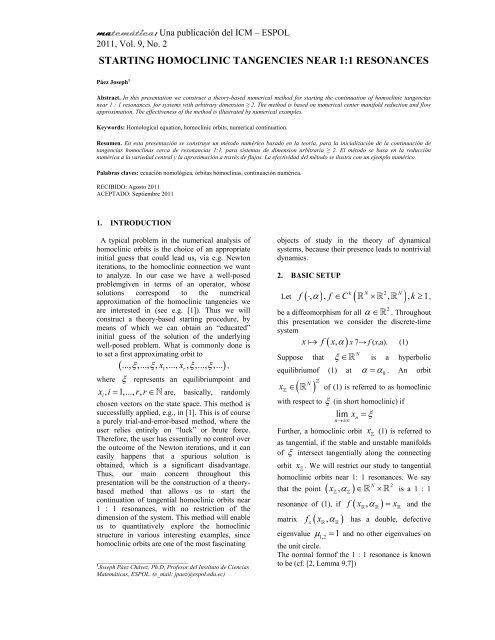matemática - Blog de ESPOL - Escuela Superior Politécnica del Litoral
matemática - Blog de ESPOL - Escuela Superior Politécnica del Litoral
matemática - Blog de ESPOL - Escuela Superior Politécnica del Litoral
Create successful ePaper yourself
Turn your PDF publications into a flip-book with our unique Google optimized e-Paper software.
<strong>matemática</strong>: Una publicación <strong>de</strong>l ICM – <strong>ESPOL</strong><br />
2011, Vol. 9, No. 2<br />
STARTING HOMOCLINIC TANGENCIES NEAR 1:1 RESONANCES<br />
Páez Joseph 1<br />
Abstract. In this presentation we construct a theory-based numerical method for starting the continuation of homoclinic tangencias<br />
near 1 : 1 resonances, for systems with arbitrary dimension ≥ 2. The method is based on numerical center manifold reduction and flow<br />
approximation. The effectiveness of the method is illustrated by numerical examples.<br />
Keywords: Homological equation, homoclinic orbits, numerical continuation.<br />
Resumen. En esta presentación se construye un método numérico basado en la teoría, para la inicialización <strong>de</strong> la continuación <strong>de</strong><br />
tangencias homoclinas cerca <strong>de</strong> resonancias 1:1, para sistemas <strong>de</strong> dimension arbitraria ≥ 2. El método se basa en la reducción<br />
numérica a la variedad central y la aproximación a través <strong>de</strong> flujos. La efectividad <strong>de</strong>l método se ilustra con un ejemplo numérico.<br />
Palabras claves: ecuación nomológica, órbitas homoclinas, continuación numérica.<br />
RECIBIDO: Agosto 2011<br />
ACEPTADO: Septiembre 2011<br />
1. INTRODUCTION<br />
A typical problem in the numerical analysis of<br />
homoclinic orbits is the choice of an appropriate<br />
initial guess that could lead us, via e.g. Newton<br />
iterations, to the homoclinic connection we want<br />
to analyze. In our case we have a well-posed<br />
problemgiven in terms of an operator, whose<br />
solutions correspond to the numerical<br />
approximation of the homoclinic tangencies we<br />
are interested in (see e.g. [1]). Thus we will<br />
construct a theory-based starting procedure, by<br />
means of which we can obtain an “educated”<br />
initial guess of the solution of the un<strong>de</strong>rlying<br />
well-posed problem. What is commonly done is<br />
to set a first approximating orbit to<br />
( ..., ξ,..., ξ, x1,..., xr,<br />
ξ,..., ξ ,... ) ,<br />
where ξ represents an equilibriumpoint and<br />
xi, i = 1,..., r, r∈are,<br />
basically, randomly<br />
chosen vectors on the state space. This method is<br />
successfully applied, e.g., in [1]. This is of course<br />
a purely trial-and-error-based method, where the<br />
user relies entirely on “luck” or brute force.<br />
Therefore, the user has essentially no control over<br />
the outcome of the Newton iterations, and it can<br />
easily happens that a spurious solution is<br />
obtained, which is a significant disadvantage.<br />
Thus, our main concern throughout this<br />
presentation will be the construction of a theorybased<br />
method that allows us to start the<br />
continuation of tangential homoclinic orbits near<br />
1 : 1 resonances, with no restriction of the<br />
dimension of the system. This method will enable<br />
us to quantitatively explore the homoclinic<br />
structure in various interesting examples, since<br />
homoclinic orbits are one of the most fascinating<br />
______________________________<br />
1 Joseph Páez Chávez, Ph.D, Profesor <strong>de</strong>l Instituto <strong>de</strong> Ciencias<br />
Matemáticas, <strong>ESPOL</strong>. (e_mail: jpaez@espol.edu.ec)<br />
objects of study in the theory of dynamical<br />
systems, because their presence leads to nontrivial<br />
dynamics.<br />
2. BASIC SETUP<br />
f ⋅, , f ∈ C × , , k ≥1,<br />
2<br />
be a diffeomorphism for all α ∈ . Throughout<br />
this presentation we consi<strong>de</strong>r the discrete-time<br />
system<br />
xf ( x, α ) x 7→ f (x,a). (1)<br />
Suppose that<br />
N<br />
ξ ∈ is a hyperbolic<br />
k N 2 N<br />
Let ( α ) ( )<br />
equilibriumof (1) at α = α0<br />
. An orbit<br />
N<br />
<br />
( )<br />
x ∈ of (1) is referred to as homoclinic<br />
with respect to ξ (in short homoclinic) if<br />
lim xn = ξ<br />
n→±∞<br />
Further, a homoclinic orbit x (1) is referred to<br />
as tangential, if the stable and unstable manifolds<br />
of ξ intersect tangentially along the connecting<br />
orbit x . We will restrict our study to tangential<br />
homoclinic orbits near 1: 1 resonances. We say<br />
N 2<br />
that the point ( x, α) ∈ × is a 1 : 1<br />
resonance of (1), if f ( x, α ) = x<br />
and the<br />
f x , α has a double, <strong>de</strong>fective<br />
matrix ( )<br />
x <br />
eigenvalue μ 1,2 = 1 and no other eigenvalues on<br />
the unit circle.<br />
The normal formof the 1 : 1 resonance is known<br />
to be (cf. [2, Lemma 9.7])

















